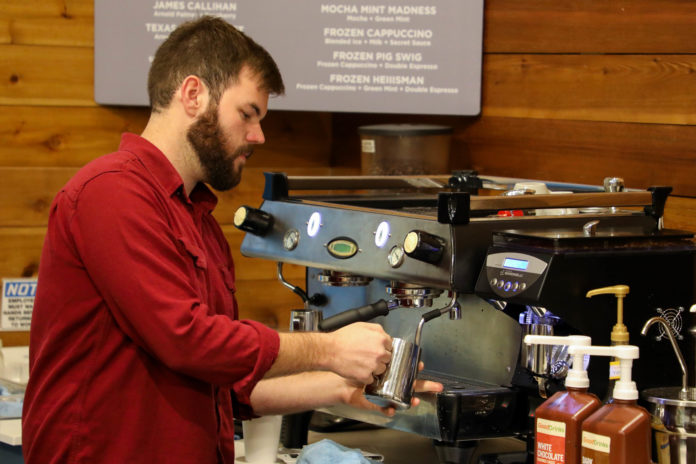
By Matthew Muir | Staff Writer
Baylor students quenched their thirst for knowledge and caffeine at the Mayborn Museum Complex’s Science of Coffee event.
Thursday night’s event was open to Baylor students, and Houston junior Gabby Hicks, an intern for the Mayborn, said it was intended to provide a relaxed atmosphere where students were encouraged to grab some refreshments, hang out and enjoy the night.
“We are marketing this as a study night and a hangout session where students can gather and see this as a very casual environment to enjoy the museum,” Hicks said. “We had a band that played, and we had catered donuts and coffee and sort of a designated study area, and then we had our main event, which was the demonstration of the science of coffee.”
Dallas seminary student and Common Grounds barista David Willhite performed demonstrations throughout the night, mixing coffee facts with a slow drip of jokes while preparing a drink. Willhite said there is a common misconception about the caffeine content of different coffee roasts.
“It’s a common misconception that dark roast [has the most caffeine,] but actually dark roast gets rid of some of the caffeine,” Willhite said. “Coffee can range from light roast to medium roast to dark roast, and there’s a super dark roast called Italian roast which basically tastes like burnt.”
Willhite walked through the process of making a mocha, beginning with the espresso.
“What’s unique about an espresso machine is that it’s really high pressure. It’s 10 times the atmospheric pressure of this room, which is a lot,” Willhite said. “That’s what allows it to have very concentrated coffee. We pour all of our coffee at Common Grounds as double shots. There’s the same amount of caffeine in a double shot as pure coffee.”
After preparing the espresso, Willhite moved on to the mocha’s next component: steamed milk. Willhite said a barista must be precise to get this part correct.
“This allows us to do two things: it makes the milk kind of silky but it also puts air into the milk to make it kind of a foam,” Willhite said. “If you submerge the steam wand too far it doesn’t change at all, it just makes hot milk, and if you don’t submerge it enough it gets really, really foamy, which some people like; it’s called a dry latte. Starbucks tends to make theirs dry; we [at Common Grounds] tend to make ours less dry.”
Waco freshman Grace Mathis said she found Willhite’s presentation to be both entertaining and informative.
“It was well-done and engaging,” Mathis said. “I learned where it came from; I didn’t know the process.”
Willhite said that where coffee beans are grown affects the drink’s taste, and Common Grounds sources coffee from numerous countries including Columbia, Ethiopia, Mexico, Costa Rica and Guatemala. He said two components are paramount when growing good coffee.
“Two things that are really important for growing coffee are altitude and water,” Willhite said. “The higher the altitude helps the water to drip off the coffee quicker [and leaves] more of the sugars on the coffee so it produces a much fruitier [flavor.]”





